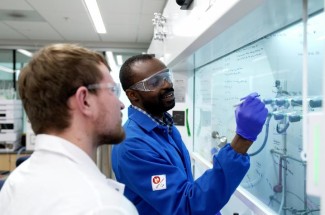UK research team develops new compound with cancer-fighting properties

University of Kentucky researchers have developed a new class of gold-based compounds that show promise in fighting various types of cancer.
The study, led by UK Markey Cancer Center researcher Samuel Awuah, Ph.D., and published in Dalton Transactions, showed that the compounds could kill cancer cells by disrupting their energy production.
The new compounds work by targeting and shutting down mitochondria, which generate energy for cells. In lab tests, they were effective against several types of cancer cells, including those from breast, ovarian and lung tumors.
The research shows how gold-based compounds can be used in a new way to fight cancer, and potentially other diseases, says Awuah, an associate professor in the UK College of Arts & Sciences Department of Chemistry.
“By creating compounds that remain stable in the body and specifically target cancer cells’ energy source, this opens the doors for the development of new and more effective treatments,” Awuah said.
The study builds upon recent research that shows auranofin — a gold-based drug approved by the FDA in 1985 for treating rheumatoid arthritis — has potential as a cancer therapy.
The research team designed the new compound to be more stable in the body than auranofin through a chemical process they refer to as “stapling.” This method joins gold molecules to other chemical structures in ways that help them resist breaking down inside cells. The increased stability means the compounds could maintain their cancer-fighting properties longer in the body, making them better-suited as a cancer therapy.
Research reported in this publication was supported by the National Cancer Institute of the National Institutes of Health under Award Number R01CA258421. The content is solely the responsibility of the authors and does not necessarily represent the official views of the National Institutes of Health.





